What, then, explains a world awash in longing, admiration, and loss in the wake of Steve Jobs’ death last week at the age of 56? Americans, perhaps, suffering their own economic travails and witnessing the ongoing and pathetic spectacle of a gridlocked political system, have stumbled upon a consensus hero, for which Jobs’ public character (iconoclasm, tenacity, charisma) and personal story (good looks, up from mean beginnings to wild fortune) offers fertile ground.
Steve Jobs’ contribution, though, may lie not in not in his personal story, not in technology, and not in any single Apple product, but in that he established the indisputable importance of design—not just that it sells, but that it is a value that people hold across domains rather than a luxury. Early on, Jobs recognized that computers were intimidating machines only a tech geek would groove on, and that design could make these machines approachable by ordinary people. This, of course, has been much noted and celebrated. But that’s not enough. It’s important to understand what it is about Apple’s designs that have made the company’s products the love-objects they are today.
Sleek artistry and obsessive attention to detail do not alone make “crazy good” design. The design of Apple products transforms them from human-made machines into objects of personal affiliation. Whether Jobs knew it or not, Apple’s products tap into hard-wired psychological predispositions regarding how humans respond to objects in their environment. That is the hidden lesson of Apple and Jobs’ success.
Looking at the pixelated screen of a monitor does not draw a person into a relationship with a computer. Jobs’ first important move, in the original Macintosh, released in 1984? The mouse. Apple did not invent the mouse linked to a personal computer system; Xerox did. But Jobs’ Apple simplified the mouse, made it ergonomically pleasant to touch and manipulate, made it curvy and cute. Humans by evolution are object manipulators. Somehow, Jobs knew: If an ordinary person is to be drawn to a computer he needs a tool he can manipulate though familiar and pre-established tactile and sensorimotor schemas, which are patterned sequences of interaction with objects in the environment. With the mouse, a person no longer needed to use the keyboard’s arrow keys to move around a text. She could click around, just as, in the process of writing, she moves pen around a piece of paper.
Perhaps the success of the original Macintosh encouraged Jobs to forge further along the path of designing technology for the type of bodies humans inhabit and minds they rely on. With the mouse, Jobs demonstrated a feel for the importance of human patterns of object manipulation. That same feel subsequently drove the development of Apple’s thin, supremely portable, soft-edged laptops, iPods, and iPhones, machines that are not burdensome to carry and feel good to hold in the hand.
In the design of the Mac computers, Jobs evinced an understanding for the human propensity toward animism. Paola Antonelli, who is the Senior Curator of Design at the Museum of Modern Art in New York, describes her first 1990 Macintosh Classic as “like a little pup dog looking at me. It wasn’t just something I worked with; it kept me company.” People routinely describe their Apple computers, whether Macs or iPads, as friends. The iMac 1998 combined the simplicity and ease of use and set up of an all-in-one with a positively anthropomorphic design: Softly curved edges frame its human face-like screen (the disc drive, a mouth). The iMac’s overall shape looks like a human head—not as a head actually presents in the world, but as a person experiences her own and others’ heads, with the face occupying far more space in our imagination than the back of the skull. Even the company logo, an apple with one bite taken out of it, draws the consumer into an imaginative action with an object. Nearly everybody knows what it feels like to bite into an apple—as is demonstrated by the many partially consumed apples left in front of Apple stores in recent days to commemorate Jobs’ death.
These and the other user-friendly qualities of all Apple’s products are not just casings on a product. They are the product. That they sold, sold, and sell tells us something important about the value people, wittingly and unwittingly, place upon design—especially upon design that taps into the inherent nature of our bodies and our minds.
